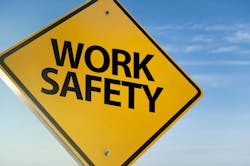Unsafe Conditions Around De-Energized Equipment, Part 3
Just because equipment is deenergized and locked/tagged out doesn’t mean it’s safe to work on. Suppose Fred responds to a trouble call; a conveyor drive motor failed. Some other hazards include:
- Falling hazard number one. While Fred is disconnecting the motor, product falls on him from the conveyor.
Solution: Operators need to clear the equipment of in-process material. - Falling hazard number two. To do the work, Fred stands on the conveyor. But it’s not mechanically locked, and it shifts as he steps on it causing Fred to fall.
Solution: Lock the conveyor, or (better) use a ladder rather than stand on equipment. - Tripping hazard. Fred stumbles over parts bins left in front of the equipment, doing a face-plant that requires a trip to the hospital.
Solution: Operators clear the work area. - Slipping hazard. Fred pulls new wiring, using cable lube. He also greases the motor. He slips and breaks his wrist.
Solution: Put down a tarp or paper to collect lubricant; clean messes as you go.
About the Author

Mark Lamendola
Mark is an expert in maintenance management, having racked up an impressive track record during his time working in the field. He also has extensive knowledge of, and practical expertise with, the National Electrical Code (NEC). Through his consulting business, he provides articles and training materials on electrical topics, specializing in making difficult subjects easy to understand and focusing on the practical aspects of electrical work.
Prior to starting his own business, Mark served as the Technical Editor on EC&M for six years, worked three years in nuclear maintenance, six years as a contract project engineer/project manager, three years as a systems engineer, and three years in plant maintenance management.
Mark earned an AAS degree from Rock Valley College, a BSEET from Columbia Pacific University, and an MBA from Lake Erie College. He’s also completed several related certifications over the years and even was formerly licensed as a Master Electrician. He is a Senior Member of the IEEE and past Chairman of the Kansas City Chapters of both the IEEE and the IEEE Computer Society. Mark also served as the program director for, a board member of, and webmaster of, the Midwest Chapter of the 7x24 Exchange. He has also held memberships with the following organizations: NETA, NFPA, International Association of Webmasters, and Institute of Certified Professional Managers.
